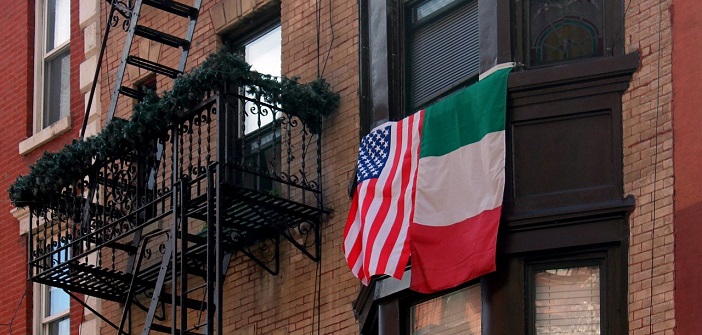Historian Rudolph J. Vecoli opposed the idea that immigrants to the United States had left their culture behind in Italy. These immigrants did their best to blend into American society. Contrary to this view, Vecoli argued that they clung tenaciously to their traditions and developed strategies to preserve their heritage. Italian-Americans push to embrace the American social and economic system. Beyond sharing the same language, these men and women gather around common symbols and institutions, such as the Italian flag or the Church.
Italian-Americans are influenced by American culture, which strives to homogenize foreign populations. These individuals must “fit the mold” of the country. The dominant ideology “invented,” at the beginning of the 20th century, the notion of the melting pot, suggesting that immigrants would quickly lose their culture to become Americanized. During a period of high immigration (about 1 million per year around 1910), the melting pot seemed reassuring, even if it usually took two or three generations for immigrants to have a spouse outside their group (melting pot). Then, after World War II, notably, the emergence of new generations born and raised in America accelerated the integration of parents still attached to their cultural heritage. Over time, Italian-Americans integrated into the country’s mainstream. The Anglo-American community served as a model of assimilation for all waves of foreign immigration.
As with all other immigrants, there is an influence from Anglo-American society. This society seeks to homogenize foreign populations. Quotas were established in 1921 under President Warren Harding with the “Emergency Quota Act,” followed three years later by the more restrictive Johnson-Reed Act. It was not Italian immigration that led to these measures but the fear of the densely populated China and imperial Japan. This fear of the Asian world and the endangerment of American supremacy led to growing xenophobia.
With these events, entry permits to American lands were reduced for both Asians and Europeans. Nearly 17 years later, World War II broke out, and the United States entered the war late on December 7, 1941. The Italian-American identity was greatly questioned. Posters put up in post offices and government buildings urged people not to speak “the enemy’s language” but to speak American:
“Don’t speak the enemy’s language! Speak American!”
This was initially because enemies of the state could be on their territory and also because there were a large number of Italians in so-called “at-risk” areas. This included those involved in skyscraper construction and those in the New York port (a topic covered in the historical section). This situation quickly evolved in favor of the Italians with the participation of Italian-Americans in World War II, and with the help of the New York and Sicilian Mafia, their place in Uncle Sam’s land was strengthened.
Subsequently, the new generation born and raised in America accelerated integration. The majority American-origin group served as a model of assimilation for foreigners.
In 1980, 6% of Italian-Americans over 65 years old were from exogamous marriages, compared to 81% of children under 5. This attested to changing mentalities. Despite the efforts of many immigrants to fit into the American mold, discrimination and prejudices persisted against them, particularly against Sicilians, after World War II.
From the early 1950s to the late 1990s, the Italian-American community was not helped by the massacre perpetrated by the Five Families in New York. However, the laws of 1965 and 1986, among others, allowed Hispanics, Asians, and the black community to immigrate more freely and easily to the United States. The country was no longer composed primarily of Irish and Italians. The ethnic recomposition became significant.


